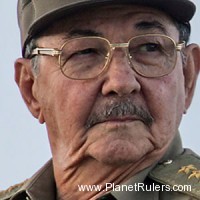Miguel Díaz-Canel, President of Cuba (since Apr 19, 2018; re-elected on Oct 10, 2019)

He was selected to succeed Raúl Castro as the candidate for President of the Council of State and the Council of Ministers on 18 April 2018, and sworn into office the following day after nationwide polling.
His two predecessors in the role were brothers, by blood, and notably his succession from Raúl Castro represents a clearly non-dynastic form of succession for the Communist Party as well as the Republic of Cuba.
Díaz-Canel is therefore the first president to not be a Castro family member since Osvaldo Dorticós only two premierships beforehand, and the third overall post-revolution, including Dorticós himself and also Manuel Urrutia Lleó. Miguel Díaz-Canel is likely to succeed Raúl Castro as First Secretary of the Communist Party of Cuba, the most important position in Cuba, in 2021.
Díaz-Canel has two children with his first wife Martha, and he currently resides with his second wife Lis Cuesta.
Source: https://en.wikipedia.org/wiki/Miguel_D%C3%ADaz-Canel
Raul Castro, Former President of Cuba

Raul Castro became acting president 18 months earlier when his brother was incapacitated by ill health, and was formally named as president by the National Assembly days after Fidel announced his retirement.
Fidel Castro, a devotee of Marxist-Leninist theory, brought revolution to Cuba and created the western hemisphere’s first communist state. His bearded figure, long speeches, army fatigues and defiance of the United States earned him iconic status across the globe.
Raul, 76 at the time of this appointment, has been his brother’s trusted right-hand man and was once known as an iron-fisted ideologue who executed Fidel Castro’s orders – and enemies – ruthlessly.
Under his leadership, Cuba’s Revolutionary Armed Forces became one of the most formidable fighting forces in the Third World with combat experience in Africa, where they defeated South Africa’s army in Angola in 1987.
Known as a good administrator, Raul Castro substantially cut the size of the army after the collapse of Soviet Communism threw Cuba into severe economic crisis. He introduced Western business practices to help make the armed forces self-sufficient. The military has a large stake in the most dynamic sectors of the Cuban economy, including tourism.
Raul Castro has also eased some restrictions on personal freedoms by lifting bans on mobile phones and home computers.
But his choice of first vice-president came as a shock to those hoping that a new generation might begin shaping the country’s future. He picked Machado Ventura – a hardline politburo member and one of the original leaders of the revolution – as his number two.
Fidel Castro, Former President of Cuba
Fidel Castro was born August 13, 1926, in Mayari municipality, province of Oriente.
As a child Fidel Castro attended Catholic schools in Santiago de Cuba and Havana.
In 1945, Fidel Castro attended the University of Havana and graduated 1950 with a law degree.
Married Mirta Diaz-Balart in 1948. Had a son, Fidel Castro Diaz-Balart, born in 1949. However, they divorced in 1954.
Fidel Castro was a vocal opponent of the dictator “Fulgencio Batista”. Fulgencio Batista had overthron the government of President Carlos Prio Socarras in a coup. Castro also was a member of the social-democratic Ortodoxo party. On July 26, 1953, Fidel Castro led an attack on the Moncada army barracks that failed. Castro was tried and sentenced to 15 years in prison. Fidel Castro was later granted amnesty in 1955.
Castro went into exile in Mexico. Here, Fidel Castro founded the 26th of July Movement. In December 1956, Fidel Castro, Che Guevara, and a small band of supporters, returned to Cuba and launched a successful guerrilla war. Batista fled Cuba, on Jan. 1, 1959.
Castro assumed power and established close ties with the Soviet Union. Fidel Castro established a “socialist” state, and nationalized industry and collectivized agriculture. In 1960, Castro confiscated the oil refineries, sugar mills, and electric utilities, that belonged to the United States. The U.S. government imposed economic sanctions on Cuba. In 1961, the U.S. Government tried to overthrow Fidel Castro in what became known as the “Bay of Pigs” Invasion.
Fidel Castro has played a major role in representing the interests of the Third World Countries in numerous forums. With the collapse of the Soviet Union, Cuba was placed under enormous difficulties, but these days is experiencing good solid growth.

